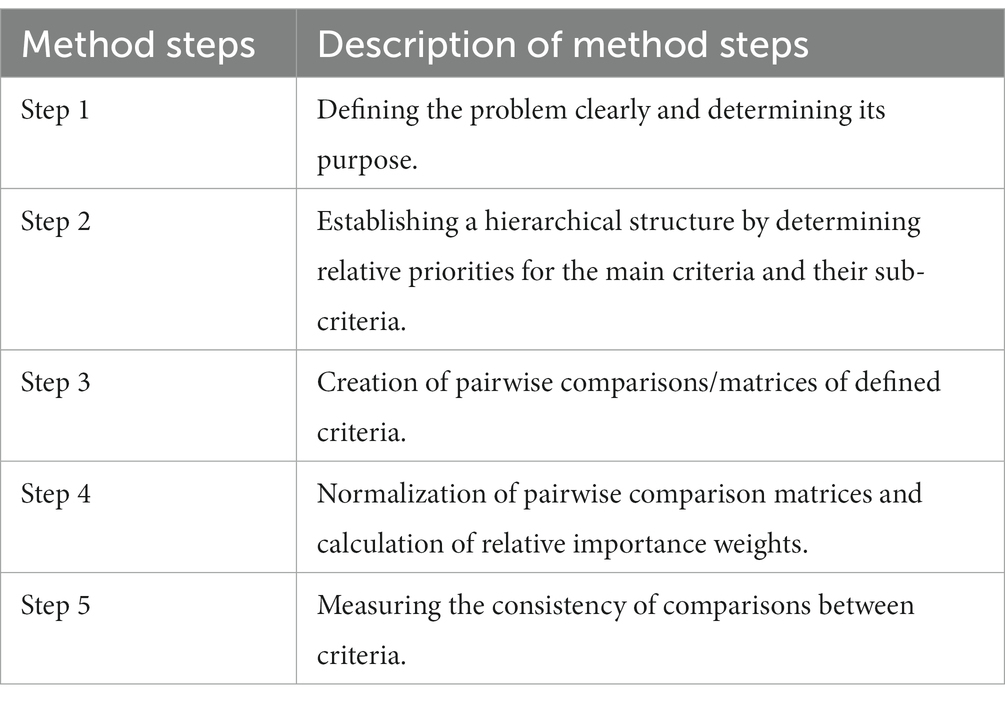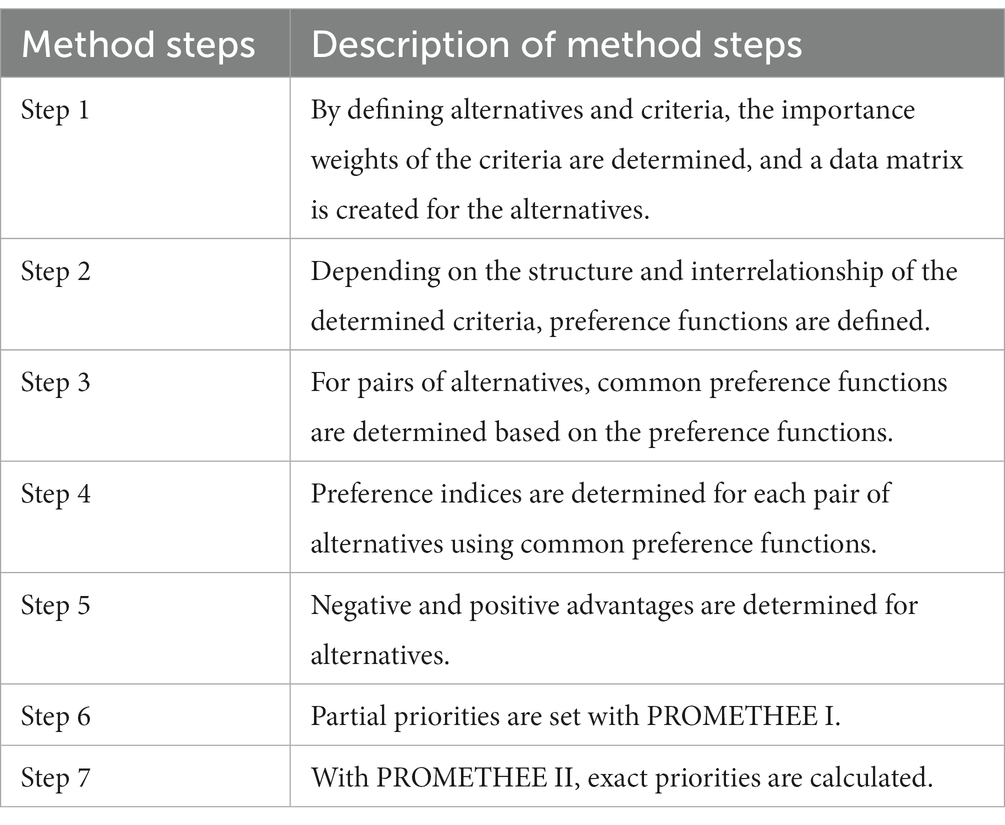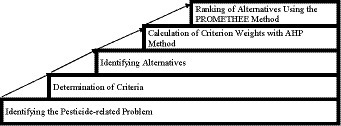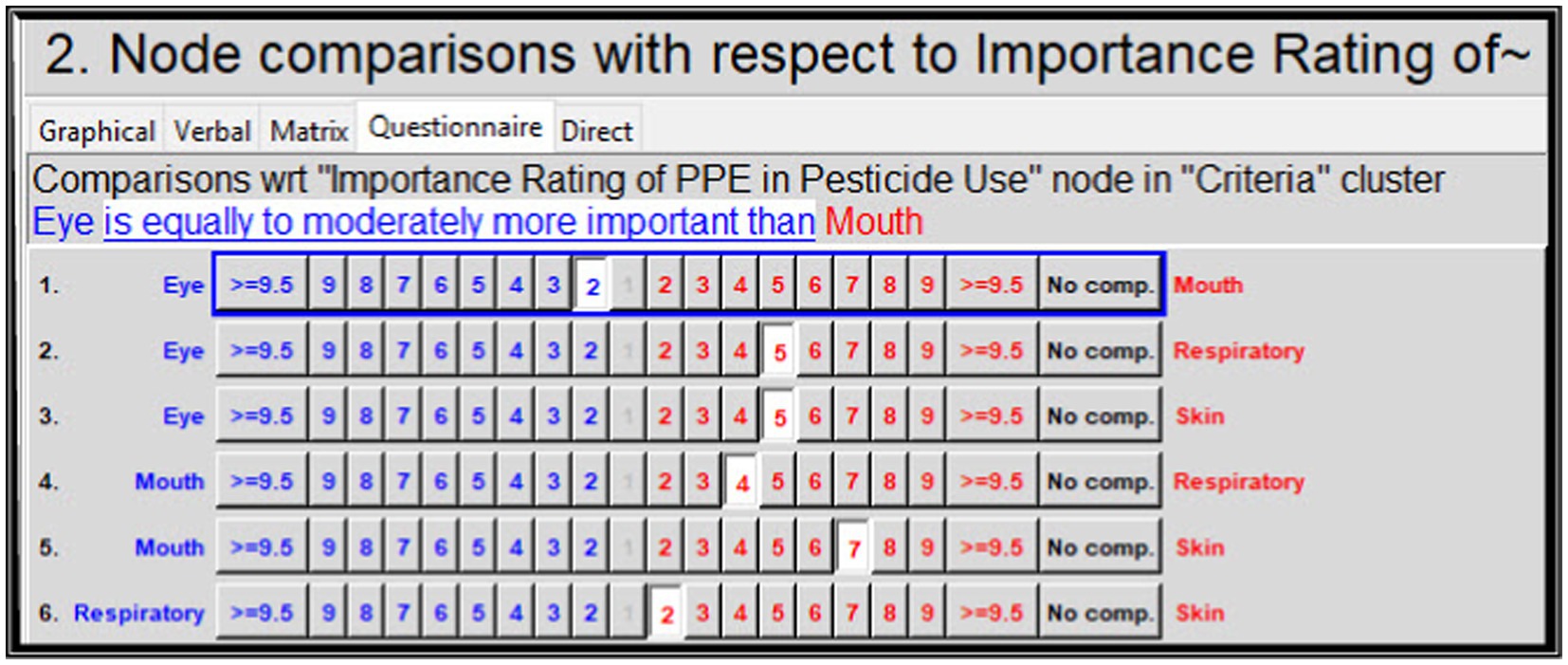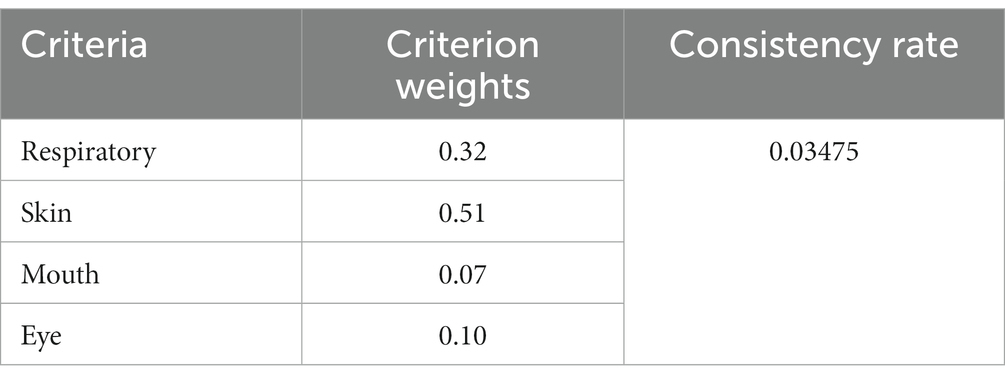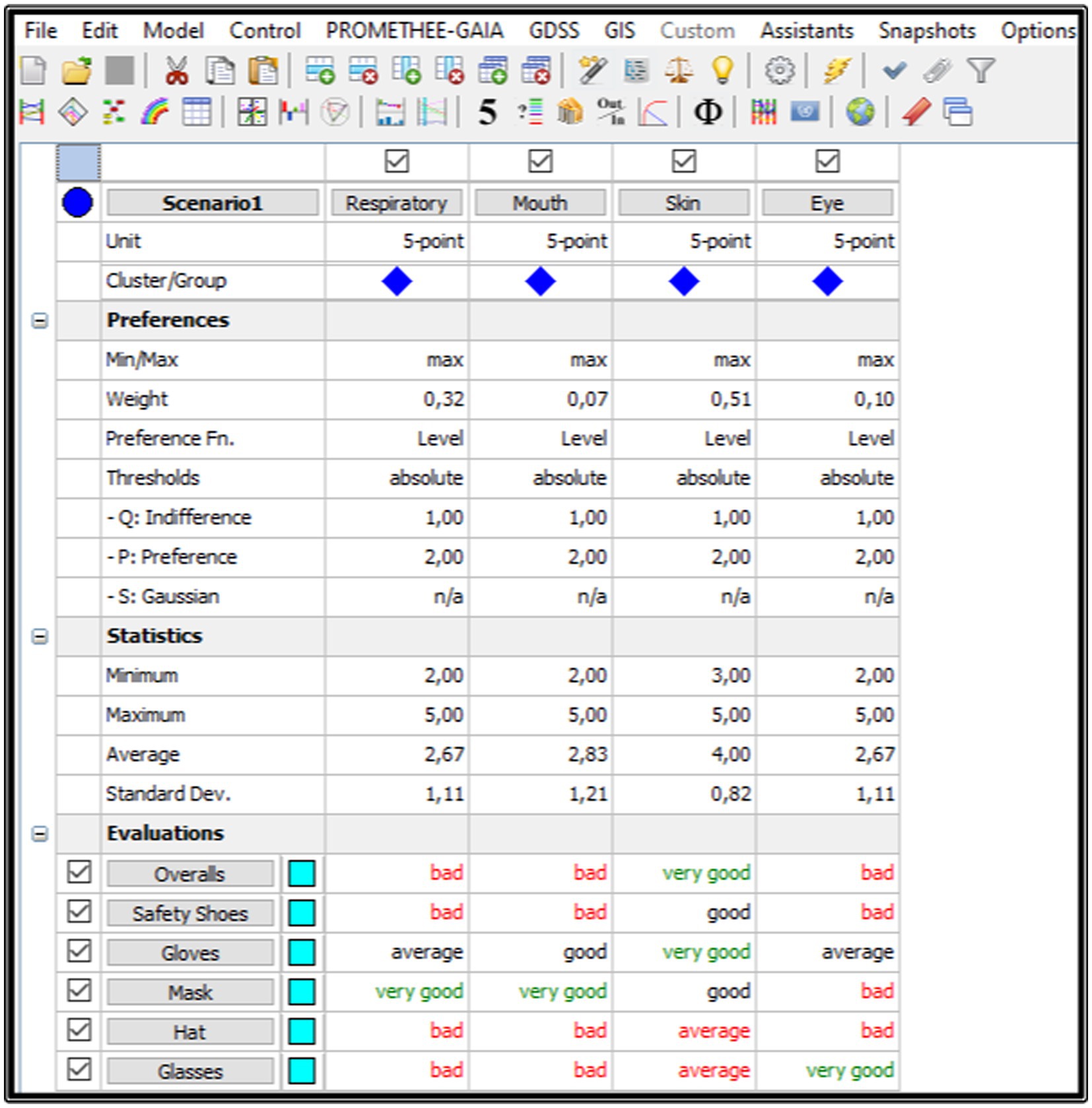- 1Ministry of Education, TOKI Mevlana Primary School, Yozgat, Türkiye
- 2Departmant of Industrial Engineering, Kırıkkale University, Kırıkkale, Türkiye
Introduction: Agriculture emerges as one of the most dangerous industries in the world, considering injury and illness rates. After the service sector in Turkey, the next large-scale sector is the agricultural sector, which constitutes 20% of the general employment. The exposure of farmers to pesticides, used to increase the quality and productivity of agricultural products, causes health risks via the mouth, respiration, skin, and eyes. Pesticide use in Turkey is increasing; the annual average increase is estimated at 1.2%. Exposure to pesticides can be reduced by wearing personal protective equipment to protect against health and safety hazards.
Objective: This study aimed to determine the importance of personal protective equipment using the multi-criteria decision-making method to prevent the risk of injury and disease resulting from pesticide use.
Materials and methods: The Analytical Hierarchy Process (AHP) method was used to find the weights of the criteria determined by expert opinion and a literature review. The Preference Ranking Organization Method for Enrichment Evaluation (PROMETHEE) was used to rank personal protective equipment.
Results: Personal protective equipment includes masks, gloves, overalls, safety shoes, glasses, and hats. The use of multi-criteria decision-making methods in health and safety in the agricultural sector will contribute to the literature.
Conclusion: Emphasizing the use of personal protective equipment, especially when using pesticides, will increase the rate of use of protective measures.
1 Introduction
Compared to other sectors, the injury and illness rates of agricultural workers in the agricultural sector emerge as one of the most dangerous sectors worldwide. Its full extent is unknown due to inconsistencies in data collection and reporting (1). The agricultural sector constitutes 20% of the general employment in Turkey. It is the largest sector after the service sector (2).
There are significant risks of disease and injury in public health and agriculture associated with pesticide use (3). Most pesticides are very harmful to both human and animal health. It can cause serious, irreversible effects on the environment. This situation causes significant contamination in all ecosystems (4). Exposure to pesticides occurs mainly via the skin and inhalation. It can also occur by consuming contaminated food, oral contact with contaminated hands, or ingestion. Another important source of exposure is contaminated clothing (5). According to the World Health Organization’s (WHO) estimation, 25 million agricultural workers are exposed to acute pesticide poisoning cases each year (3). Risk perception variables of pesticide use that threaten the environment and human health can play an essential role in farmers’ taking safety measures (6). WHO classifies pesticides as moderately hazardous toxicity class II, which can lead to health risks if unsafe equipment is used by farmers (7). WHO and the International Labor Organization (ILO) recommend that farmers use personal protective equipment (PPE) to protect their health by reducing their exposure to pesticides (8).
Employee-specific clothing or equipment worn by employees to avoid exposure to health and safety hazards is called PPE. Various PPEs have been designed to protect many body parts, such as the eyes, hands, feet, head, ears, and face (9). Although its use is the least preferred solution, it should be considered in solving professional problems within a systematic and integrated vision. For this reason, the effectiveness of the entire occupational health and safety system and the balanced selection of alternatives for prevention, protection, and control are closely related (10). There are chemical, biological, and physical hazards in working environments. It is a known fact that the quality of workplaces increases with environmental management measures and engineering approaches that protect their employees by reducing or eliminating the danger factors. However, it is not disputed that many fields of study also need to implement such decisive, practical measures. In such cases, a business management approach using PPE is considered an alternative and essential tool to protect the health and safety of employees (11).
In this study, the importance of ranking PPE using Multi-Criteria Decision-Making (MCDM) methods was discussed to prevent the risk of injury and disease caused by pesticide use. The criterion weights of PPE were determined using the AHP method and ranked using the PROMETHEE method.
There are studies on pesticides in the literature. Clark et al. (12) investigated the attitudes, knowledge, and practices of 123 agricultural workers regarding the safe use of pesticides at three irrigation project sites in the Accra Plains, Ghana. Gomes et al. (13) investigated the use of PPE and the application of hygiene and safety procedures to process pesticides in agriculture. Nordin et al. (14) studied the effects of pesticide use-related safety behaviors on the onset of acute organ symptoms in 101 female and 395 male tobacco-growing Malaysian farmers. Mekonnen and Agonafir (15) presented data on pesticide use, PPE use, attitudes, applications, and knowledge of pesticide sprayers on large Ethiopian farms. Reed (16) conducted studies to determine the self-protective work behaviors, risk exposures, and use of personal protective equipment of children on farms. Reed emphasized the need to be informed about personal protective equipment. Atreya (17) studied how pesticide use affects the health of farmers in Nepal. The study aimed to understand acute health symptoms and estimate health costs in rural Nepal concerning pesticide exposure. The study revealed that pesticide use had acute effects on health. Weerasinghe et al. (18) aimed to receive detailed user notifications regarding the differences in pesticide storage, evaluate the use of pesticide-safe storage devices, and identify problems related to crucial protection. Fenske (19) provided field demonstrations and discussions on traumatic and musculoskeletal injuries in orchards, mobile work platforms, and new pest control technologies. Levesque and Shen (20) aimed to investigate the relationship between the housing conditions of agricultural workers, pesticide safety practices, and PPE use. Meirelles et al. (21) examined the efficiency of using PPE in agriculture through a theoretical framework. They developed an analysis of PPE design by controlling the unhealthy conditions of rural workers. Almeida et al. (22) examined the inadequacy of PPE used in tomato crops, especially thermal comfort. Their study showed that insufficient use of PPE may pose a risk of thermoregulation for rural workers. Basilicata et al. (23) investigated agricultural workers’ general working conditions and pesticide exposure in tomato-growing farms in southern Italy during the mixing/loading and applying of pesticides to the fields. Lekei et al. (24) aimed to explain farmers’ knowledge of pesticide hazards, pesticide exposure profiles, unsafe practices that cause acute poisoning, the extent to which acute poisoning was reported, and previous poisoning experiences. Al Zadjali et al. (25) conducted their studies to investigate the differences between farm types in PPE use, identify the key people responsible for pesticide applications, and store pesticides safely. In their study, Andrade-Rivas and Andrea Rother (26) aimed to analyze the risk perceptions related to the socio-cultural context, working conditions, and herbicide use to understand the employees’ low PPE compliance. The study results revealed that although workers were informed about herbicide exposure risks, PPE use continued at a low rate due to workers being affected by working conditions, herbicide risk perceptions, and workers’ social status and gender dynamics. Rudolphi (27) aimed to determine agricultural educators’ attitudes, needs, and practices about agricultural safety and health. Ngowi et al. (28) aimed to reveal that national pesticide regulations need to be revised to solve the health and safety problems encountered by agricultural workers in Tanzania in the use of pesticides on a small scale. Sawada et al. (11) aimed to present the latest information on the development and evaluation. Akter et al. (29) aimed to examine the behavioral activities of farmers regarding their pesticide use and determine the relevant factors affecting the use. Yarpuz-Bozdogan (30) emphasized the importance of using PPE in pesticide applications in agriculture. Reynolds et al. (31) obtained descriptive findings regarding pesticide use from 1,191 participants who completed occupational surveys in the study, which included an in-depth evaluation of injuries, respiratory diseases, and other health consequences related to environmental and occupational exposures. Rezaei et al. (32) aimed to fill the gap with healthy spread theory and planned behavior theory, which include perceived sensitivity and severity structures for the factors affecting Iranian farmers’ PPE use. Sapbamrer and Thammachai (33) reviewed the existing literature on PPE use by pesticide processors in different regions of the world. Joko et al. (34) investigated the symptoms of poisoning caused by farmers’ pesticide exposure. Jakob et al. (35) defined and classified the national occupational health and safety mechanisms in Europe for agricultural workers and aimed to exemplify the scope of implementation of the safety regulation by evaluating the responsible institution for health and safety initiatives. Zhang et al. (36) investigated the work-related risk factors and prevalence level of acute pesticide poisoning among farmers in southern China. Those who experienced work-related acute pesticide poisoning constituted 8.8% of the total pesticide applicators. Paschoalin et al. (37) reported on a non-enzymatic wearable electrochemical sensor that can detect bipyridinium and carbamate pesticides on the surface of food and agricultural samples. This sensor can detect diquat and carbendazim in apple and cabbage skins without the interference of other pesticides and determine in what proportion they are present. They stated that this type of wearable sensor, including active bio(sensing) layers, could be extended to other agrochemicals and monitor all agri-foods and products online.
To the best of our knowledge, no study was found to determine the importance of PPE for preventing diseases and injuries associated with pesticide use using the MCDM method as a result of the literature research. Its contribution to the literature will be applying these methods to the agricultural sector. Emphasizing the use of PPE in the processing of pesticides in agriculture will increase the tendency of agricultural workers to use protective measures.
2 Materials and methods
Criteria were determined based on a literature review and expert opinion. The criteria weights were calculated with the AHP method, which is one of the MCDM methods, and the importance of the alternatives was ranked using the PROMETHEE method.
2.1 AHP method
When applied to decision-making, the AHP method, one of the most well-known MCDM methods, helps define the general decision process by decomposing a complex problem into a hierarchical structure as the target, criterion, subcriteria, and alternative (38). Pairwise comparisons are made to obtain priority scales based on experts’ judgments. Comparisons are made using an absolute judgment scale relative to a particular attribute, representing how much one element dominates another (38). In AHP, the relative importance of decision criteria is evaluated through pairwise comparisons. The decision-maker examines the two alternatives to create a priority value (aij) for each criterion and expresses a preference. In AHP, the standard numerical scale is 1–9, which ranges from “extremely important” to “equally important.” A value of “1” indicates that one factor is equally important as another, while a “9” indicates that one factor is highly less critical than the other. An n*n square matrix is obtained at each level of the criterion hierarchy, where n is the number of elements of the level (39).
The method steps are listed in Table 1 (38, 40).
2.2 PROMETHEE method
The PROMETHEE method is one of the MCDM methods and has a significant place. PROMETHEE I, developed by Jean Pierre Brans in 1982, offers partial prioritization. PROMETHEE II, on the other hand, offers clear prioritization (41). The PROMETHEE method, developed based on the difficulties of the prioritization methods applied in the existing literature, has become a frequently used method today (42).
With the PROMETHEE methodology, successful applications in many areas, such as investments, workforce planning, industrial location, banking, water resources, chemistry, medicine, health services, dynamic management, tourism, and ethics in the operating room, have been discussed. The methodology can be applied in many fields due to its ease of use and mathematical properties (41).
Method steps are listed in Table 2 (43).
3 Results
Figure 1 shows the problem flow chart.
3.1 Problem definition
Occupational death, injury, and disease are high among agricultural workers. Agricultural workers risk work-related injuries and illnesses more than most other occupations. The three most dangerous sectors are agriculture, construction, and mining (44). Eurostat statistics reported that in 2013, in EU agriculture, 1.5 non-fatal injuries occurred per 100 workers, while 4.1 fatal injuries occurred per 100,000 workers. However, these rates are represented at a lower level than the actual rates. Because people outside the family do 25% of the work, reporting occupational injuries is optional for the self-employed (1). Pesticide use in agriculture is significant as it adversely affects the health of farmers (14, 17, 28, 34). A significant risk of disease and injury in public health and agriculture is associated with pesticide use. According to WHO estimates, 25 million agricultural workers in developing countries are exposed to acute pesticide poisoning every year (3).
Statistical results revealed that 25 million farmers are poisoned every year, with a mild degree of poisoning. In addition, nearly three million farmers, especially those living in rural areas of developing countries, are exposed to severe pesticide poisoning (29). As a result, 180,000 people, including various agricultural workers, experience fatal events every year (36). In particular, the lack of use of PPE and the lack of appropriate safety behaviors by farmers before, during, and after pesticide application are the most important reasons for the high incidence rate (15, 20, 29, 33). Wearing PPE can reduce the possibility of poisoning by approximately 44% (45). Although it is the least preferred solution, PPE for professional problems should be considered within an integrated and systematic vision. Therefore, the effectiveness of the entire occupational health and safety system for prevention, protection, and control is closely related to the balanced selection of alternatives (10).
This study discusses the problem of sequencing the use of PPEs with the MCDM method to prevent the risk of injury and disease related to pesticide use. Personal protective equipment is worn or used to protect people from various hazards, eliminating and reducing the risk of fatal and non-fatal unintentional work injuries (46).
3.2 Determination of criteria
Pesticides are biologically active chemicals widely used by many agricultural workers and those involved in vector control. Occupational exposure occurs during the mixing, dilution, transport, application, and disposal of pesticides, as well as during the processing of crops and the cleaning of containers (5). Pesticides can enter the body through skin absorption, ingestion, and inhalation. To reduce exposure to pesticides and maintain health, the ILO and WHO recommend that farmers use PPE during pesticide application (8). This study addressed the importance of employees using PPE as a risk reduction measure. The criteria determined by considering the literature and expert opinion were respiratory, skin, swallowing, and eye (5, 8, 47).
3.3 Identifying alternatives
There are various hazards in the workplace, such as chemical, physical, and biological. It is indisputable that protecting employees from these existing dangers, reducing or eliminating harmful factors, improving the quality of workplaces with an engineering approach, and taking environmental management measures are priority solutions. However, it is a fact that such decisive and effective measures cannot be implemented in many fields of study. In such cases, a work management approach using PPE is considered an alternative and essential tool to protect the safety and health of employees (11). Among pesticide handlers, the most basic PPE coveralls are safety shoes, respirators, gloves, masks, boots, aprons, hats, long-sleeved pants, long-sleeved shirts, face shields, and goggles. In this study, alternatives were determined as masks (face visors), overalls (long-sleeved trousers and shirts), safety shoes (boots), gloves, glasses, and hats. Alternatives were determined based on expert opinions and literature (15, 20, 25, 33, 34, 48).
3.4 Finding criterion weights with the AHP method
The visual PROMETHEE Academic Version Program was used to perform AHP calculations. Figure 2 shows the hierarchical structure.
The group comprising eight experts included two academicians who are industrial engineers, a doctor in the field of occupational health and safety, a class A occupational health and safety specialist, a class B occupational health and safety specialist, a class C occupational health and safety specialist, an occupational health and safety technician, and a medical doctor. The experts were selected based on their experience in the health and safety field. Pairwise comparisons were made based on expert opinions. Saaty’s 1–9 scale was used in pairwise comparisons as shown in Table 3 (40). The consistency ratio, which is less than 0.1, was met. Figure 3 shows the pairwise comparison.
Criterion weights were found using the Super Decision Program. The obtained criterion weights are given in Table 4.
3.5 Ranking of alternatives using the PROMETHEE method
Alternatively, the mask, overalls, safety shoes, gloves, glasses, and hat will be ordered using the PROMETHEE method. The criterion weights obtained by the AHP method were entered into the Visual PROMETHEE Academic Version Program. The preference functions to be used in problem-solving are listed in Table 5 (41). In our study, the Fourth Type (Level) Function was used. While the login screen is shown in Figure 4, the ranking of the alternatives is given in Table 6.
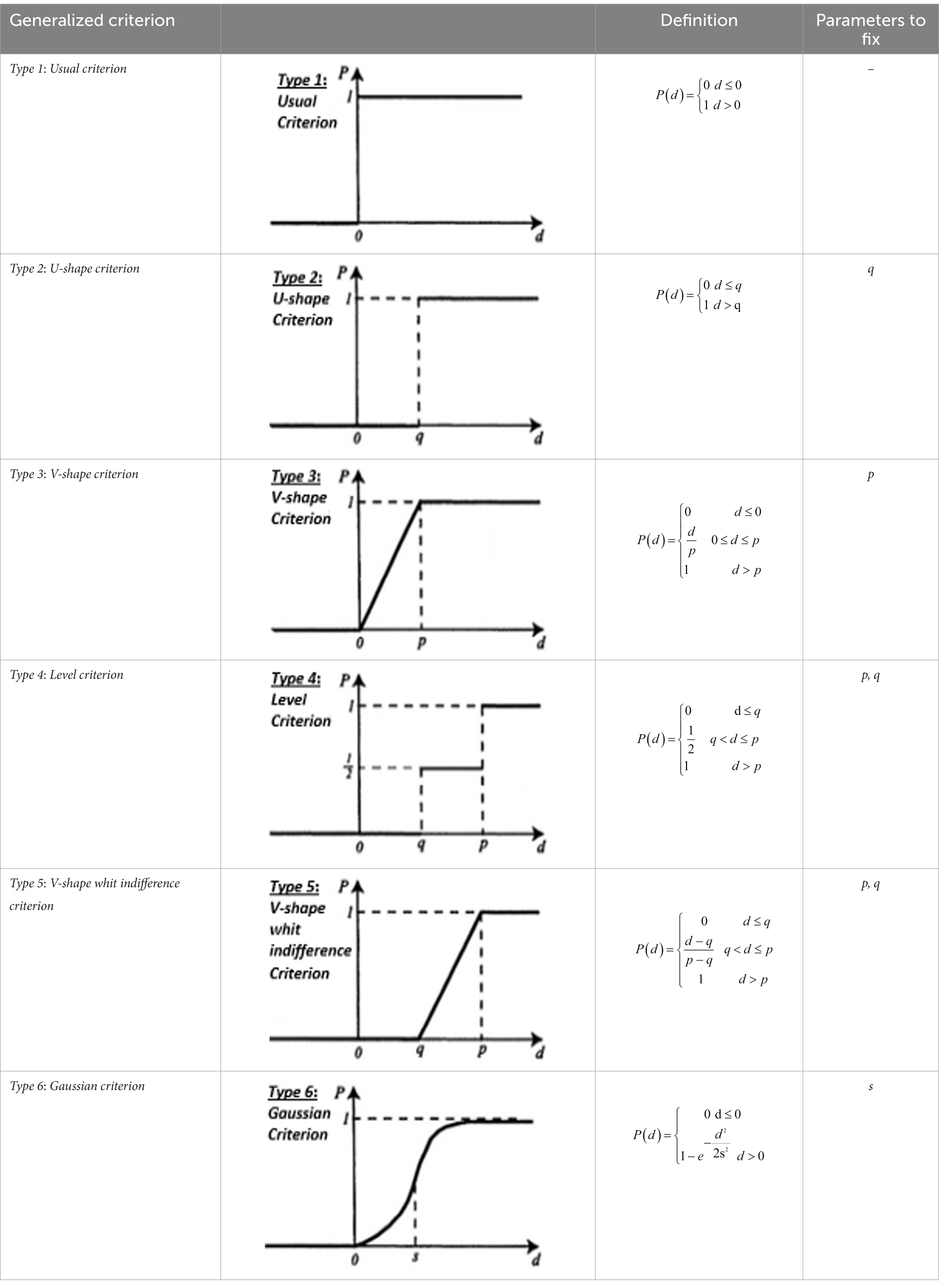
Table 5. Preference functions (41).
Table 6 shows the results of ranking the alternatives using the PROMETHEE method. When obtaining the Phi net priority value, the difference between the positive superiority Phi+ value and the negative superiority Phi-values is taken. Alternatives are ranked according to their net priority values. According to the results of the PROMETHEE flow table, the order of PPE is listed as masks, gloves, overalls, safety shoes, glasses, and hats.
4 Discussion
The order of the PPE used to prevent the risk of injury and disease related to pesticide use using AHP and PROMETHEE methods is listed as a mask, gloves, coveralls, safety shoes, glasses, and hat.
Respiratory protective masks should be used in spraying operations and should be comfortable and breathing resistance appropriate when worn on the face. Goggles should prevent the chemicals used during spraying from getting into the eyes and the chemical vapors from entering the eyes. Various accidents are encountered with chemicals in liquid form after splashing and spilling on the feet or legs. Work boots and shoes should be used to prevent accidents. Hygiene rules should be observed in shoes and boots, and necessary ventilation rules should be applied. Appropriate gloves must be used, as chemicals will damage the skin in manual spraying applications. Contact with and absorption of chemicals on the skin should be prevented. Gloves should be decontaminated before removal, whenever possible. Overalls (work clothes) are the clothes that employees wear while working. It is essential to use it so that employees can protect themselves against chemical risks. The work clothes used should be removed in a separate section at the end of the work. Removed clothes should be appropriately disinfected (49). The hat used by farmers while spraying effectively prevented the symptoms significantly (14).
Pesticides are biologically active chemicals commonly used by agricultural workers and those involved in vector control. The most commonly used pesticides are organophosphate, carbamate, and pyrethroid insecticides (34). Occupational exposure also occurs during mixing, transporting, diluting, applying, and disposing of pesticides while processing crops and cleaning containers. Exposure occurs mainly through dermal and inhalation routes. Ingestion can occur through oral contact with contaminated hands or consuming contaminated food. A significant source of exposure is contaminated clothing (5). In the study, the criterion weights were skin 0.51, respiration 0.32, eye listed 0.10, and mouth 0.07. Since pesticide exposure mainly occurs through the dermal route during the preparation of sprays and through dermal and inhalation during application (50), dermal intake has the highest weight in the ranking, followed by breathing, eyes, and mouth intake. PPE use during spraying can reduce pesticide inhalation and contact with pesticides, potentially reducing the chronic and acute health hazards of pesticides for sprayers (15). Recently, smart devices such as Internet of Things (IoT)-based drones, wireless sensors, and robots have been able to identify the crop enemies of the growers precisely, reducing the use of pesticides significantly (51, 52).
5 Conclusion
The agricultural sector constitutes 20% of the general employment in Turkey (2). Pesticide use negatively affects the health of farmers in this significant sector (14, 17, 28, 34). PPE provides additional protection against exposure to hazardous conditions in agricultural production when workers’ safety is not addressed by controlling the risk at the source, eliminating the hazard, or minimizing the risk (53). This study discusses the problem of ranking the PPEs with the MCDM method to prevent the risk of injury and disease related to pesticide use. The weights of the criteria determined according to the literature review and expert opinion were calculated with the AHP method, and the PPE determined as an alternative was ranked using the PROMETHEE method. In the ranking, the order of PPE was included as a mask, gloves, overalls, safety shoes, glasses, and hat.
In future, studies can be carried out on using products based on Internet of Things (IoT) technology to prevent pesticide exposure and protect the health and safety of workers.
Data availability statement
The original contributions presented in the study are included in the article/supplementary material, further inquiries can be directed to the corresponding author.
Author contributions
GA: Conceptualization, Data curation, Software, Validation, Visualization, Writing – original draft, Writing – review & editing. TE: Methodology, Validation, Writing – review & editing.
Funding
The author(s) declare that no financial support was received for the research, authorship, and/or publication of this article.
Conflict of interest
The authors declare that the research was conducted in the absence of any commercial or financial relationships that could be construed as a potential conflict of interest.
Publisher’s note
All claims expressed in this article are solely those of the authors and do not necessarily represent those of their affiliated organizations, or those of the publisher, the editors and the reviewers. Any product that may be evaluated in this article, or claim that may be made by its manufacturer, is not guaranteed or endorsed by the publisher.
References
1. Merisalu, E, Leppälä, J, Jakob, M, and Rautiainen, R. Variation in Eurostat and national statistics of accidents in agriculture. Agron Res. (2019) 17:1969–83. doi: 10.15159/ar.19.190
2. Akyıldız, S, Çakmak, B, Alayunt, F, and Karakitapoğlu, N. In the agricultural sector, the impact of media on the development of occupational health and safety cultures. J Eng Sci Design. (2017) 5:257–61. doi: 10.21923/jesd.37308
3. Jeyaratnam, J. Acute pesticide poisoning: a major global health problem. World Health Stat Q. (1990) 43:139–44.
4. Carvalho, F. Pesticides, environment, and food safety. Food Energy Sec. (2017) 6:48–60. doi: 10.1002/fes3.108
6. Bhandari, G, Atreya, K, Yang, X, Fan, L, and Geissen, V. Factors affecting pesticide safety behaviour: the perceptions of Nepalese farmers and retailers. Sci Total Environ. (2018) 631-632:1560–71. doi: 10.1016/j.scitotenv.2018.03.144
7. Atreya, K, Johnsen, F, and Sitaula, B. Health and environmental costs of pesticide use in vegetable farming in Nepal. Environ Dev Sustain. (2012) 14:477–93. doi: 10.1007/s10668-011-9334-4
9. Aderaw, Z, Engdaw, D, and Tadesse, T. Determinants of occupational injury: a case control study among textile factory workers in Amhara regional state, Ethiopia. J Trop Med. (2011) 2011:1–8. doi: 10.1155/2011/657275
11. Sawada, SI, Kuklane, K, Wakatsuki, K, and Morikawa, H. New development of research on personal protective equipment (PPE) for occupational safety and health. Ind Health. (2017) 55:471–2. doi: 10.2486/indhealth.55-471
12. Clarke, E, Levy, L, Spurgeon, A, and Calvert, I. The problems associated with pesticide use by irrigation workers in Ghana. Occup Med. (1997) 47:301–8. doi: 10.1093/occmed/47.5.301
13. Gomes, J, Lloyd, O, and Revitt, D. The influence of personal protection, environmental hygiene and exposure to pesticides on the health of immigrant farm workers in a desert country. Int Arch Occup Environ Health. (1999) 72:40–5. doi: 10.1007/s004200050332
14. Nordin, R, Araki, S, Sato, H, Yokoyama, K, Wan Muda, WM, and Win, KD. Effects of safety behaviours with pesticide use on occurrence of acute symptoms in male and female tobacco-growing Malaysian farmers. Ind Health. (2002) 40:182–90. doi: 10.2486/indhealth.40.182
15. Mekonnen, Y, and Agonafir, T. Pesticide sprayers knowledge, attitude and practice of pesticide use on agricultural farms of Ethiopia. Occup Med. (2002) 52:311–5. doi: 10.1093/occmed/52.6.311
16. Reed, D, Browning, S, Westneat, S, and Kidd, P. Personal protective equipment use and safety behaviors among farm adolescents: gender differences and predictors of work practices. J Rural Health. (2006) 22:314–20. doi: 10.1111/j.1748-0361.2006.00052.x
17. Atreya, K. Health costs from short-term exposure to pesticides in Nepal. Soc Sci Med. (2008) 67:511–9. doi: 10.1016/j.socscimed.2008.04.005
18. Weerasinghe, M, Pieris, R, Eddleston, M, Hoek, W, Dawson, A, and Konradsen, F. Safe storage of pesticides in Sri Lanka – identifying important design features influencing community acceptance and use of safe storage devices. BMC Public Health. (2008) 8:1–10. doi: 10.1186/1471-2458-8-276
19. Fenske, R. New technologies and worker safety in western agriculture. J Agromedicine. (2009) 14:417–20. doi: 10.1080/10599240903260592
20. Levesque, D, Arif, A, and Shen, J. Association between workplace and housing conditions and use of pesticide safety practices and personal protective equipment among North Carolina farmworkers in 2010. Int J Occup Environ Med. (2012) 3:53–67.
21. Meirelles, L, Veiga, M, and Duarte, F. Efficiency of personal protective equipment used in agriculture. Work. (2012) 41:14–8. doi: 10.3233/WOR-2012-0129-14
22. de Almeida, RA, Veiga, MM, De Costa Moura Duarte, FJ, Meirelles, LA, and Veiga, BEL. Thermal comfort and personal protective equipment (PPE). Work. (2012) 41:4979–82. doi: 10.3233/WOR-2012-0042-4979
23. Basilicata, P, Sımonell, A, Sılvestre, A, Lambert, M, Pedata, P, Feola, D, et al. Evaluation by environmental monitoring of pesticide absorption in farm workers of 18 Italian tomato cultivations. Int J Immunopathol Pharmacol. (2013) 26:517–23. doi: 10.1177/039463201302600226
24. Lekei, EE, Ngowi, AV, and London, L. Farmers' knowledge, practices and injuries associated with pesticide exposure in rural farming villages in Tanzania. BMC Public Health. (2014) 14:1–13. doi: 10.1186/1471-2458-14-389
25. Al Zadjali, S, Morse, S, Chenoweth, J, and Deadman, M. Personal safety issues related to the use of pesticides in agricultural production in the Al-Batinah region of Northern Oman. Sci Total Environ. (2015) 502:457–61. doi: 10.1016/j.scitotenv.2014.09.044
26. Andrade-Rivas, F, and Rother, HA. Chemical exposure reduction: factors impacting on South African herbicide sprayers’ personal protective equipment compliance and high risk work practices. Environ Res. (2015) 142:34–45. doi: 10.1016/j.envres.2015.05.028
27. Rudolphi, J, and Retallick, M. Agricultural safety and health education: practices, attitudes, and needs of Iowa agricultural educators. NACTA J. (2015) 59:174–9.
28. Ngowi, A, Mrema, E, and Kishinhi, S. Pesticide health and safety challenges facing informal sector workers: a case of small-scale agricultural workers in Tanzania. New Solut. (2016) 26:220–40. doi: 10.1177/1048291116650262
29. Akter, M, Fan, L, Rahman, M, Geissen, V, and Ritsema, C. Vegetable farmers’ behaviour and knowledge related to pesticide use and related health problems: a case study from Bangladesh. J Clean Prod. (2018) 200:122–33. doi: 10.1016/j.jclepro.2018.07.130
30. Yarpuz-Bozdogan, N. The importance of personal protective equipment in pesticide applications in agriculture. Curr Opin Environ Sci Health. (2018) 4:1–4. doi: 10.1016/j.coesh.2018.02.001
31. Reynolds, SJ, Tadevosyan, A, Fuortes, L, Merchant, JA, Stromquist, AM, Burmeister, LF, et al. Keokuk County rural health study: self-reported use of agricultural chemicals and protective equipment. J Agromedicine. (2018) 12:45–55. doi: 10.1080/10599240801887850
32. Rezaei, R, Seidi, M, and Karbasioun, M. Pesticide exposure reduction: extending the theory of planned behavior to understand Iranian farmers’ intention to apply personal protective equipment. Saf Sci. (2019) 120:527–37. doi: 10.1016/j.ssci.2019.07.044
33. Sapbamrer, R, and Thammachai, A. Factors affecting use of personal protective equipment and pesticide safety practices: a systematic review. Environ Res. (2020) 185:109444. doi: 10.1016/j.envres.2020.109444
34. Joko, T, Dewanti, N, and Dangiran, H. Pesticide poisoning and the use of personal protective equipment (PPE) in Indonesian farmers. J Environ Public Health. (2020) 2020:1–7. doi: 10.1155/2020/5379619
35. Jakob, M, Santa, D, Holte, K, Sikkeland, I, Hilt, B, and Lundqvist, P. Occupational health and safety in agriculture-a brief report on organization, legislation and support in selected European countries. Ann Agric Environ Med. (2021) 28:452–7. doi: 10.26444/aaem/140197
36. Zhang, LS, Li, J, Wang, F, Shi, JD, Chen, W, and Tao, XM. Flexible stimuli-responsive materials for smart personal protective equipment. Mater Sci Eng. (2021) 146:100629. doi: 10.1016/j.mser.2021.100629
37. Paschoalin, R, Gomes, N, Almeida, G, Bilatto, S, Farinas, C, Machado, S, et al. Wearable sensors made with solution-blow spinning poly (lactic acid) for non-enzymatic pesticide detection in agriculture and food safety. Biosens Bioelectron. (2022) 199:113875. doi: 10.1016/j.bios.2021.113875
38. Saaty, TL. The analytic hierarchy process in conflict management. Int J Conf Manag. (1990) 1:47–68. doi: 10.1108/eb022672
39. Benmoussa, K, Laaziri, M, Khoulji, S, Kerkeb, M, and El Yamam, A. AHP-based approach for evaluating ergonomic criteria. Proc Manufact. (2019) 32:856–63. doi: 10.1016/j.promfg.2019.02.294
40. Saaty, TL. Decision making with the analytic hierarchy process. Int J Serv Sci. (2008) 1:83–98. doi: 10.1504/IJSSCI.2008.017590
41. Brans, JP, and Mareschal, B. Promethee methods. In: Multiple criteria decision analysis: state of the art surveys. international series in operations research & management science, J Figueira, S Greco, and M Ehrogott editors. vol. 78. New York, NY: Springer (2005). 163–86.
42. Dağdeviren, M, and Eraslan, E. Supplier selection with PROMETHEE sorting method. J Gazi Univ Fac Eng Archit. (2008) 23:69–75.
43. Brans, JP, and Vinck, P. Note—a preference ranking organisation method: (the PROMETHEE method for multiple criteria decision-making). Manag Sci. (1985) 31:647–56. doi: 10.1287/mnsc.31.6.647
45. Dasgupta, S, Meisner, C, Wheeler, D, Xuyen, K, and Lam, N. Pesticide poisoning of farm workers–implications of blood test results from Vietnam. Int J Hyg Environ Health. (2007) 210:121–32. doi: 10.1016/j.ijheh.2006.08.006
46. Bhattacharjee, S, Joshi, R, Chughtai, A, and Macintyre, C. Graphene modified multifunctional personal protective clothing. Adv Mater İnter. (2019) 6:1900622. doi: 10.1002/admi.201900622
47. Eddleston, M. Poisoning by pesticides. Medicine. (2020) 48:214–7. doi: 10.1016/j.mpmed.2019.12.019
48. Chughtai, A, and Macintyre, C. Risk of self-contamination during doffing of personal protective. Am J Infect Control. (2018) 46:1329–34. doi: 10.1016/j.ajic.2018.06.003
49. Özdemir, F, Bulduk, İ, and Karakaş, K. Chemical risk factors in agricultural sector olive growing. Ohs Academy. (2020) 3:35–40. doi: 10.38213/ohsacademy.703878
50. WHO. Preventing disease through healthy environments: exposure to highly hazardous pesticides: a major public health concern. Geneva: World Health Organization (2019).
51. Kim, S, Lee, M, and Shin, C. IoT-based strawberry disease prediction system for smart farming. Sensors. (2018) 18:4051. doi: 10.3390/s18114051
52. Venkatesan, R, Kathrine, G, and Ramalakshmi, K. Internet of things based pest management using natural pesticides for small scale organic gardens. J Comput Theor Nanosci. (2018) 15:2742–7. doi: 10.1166/jctn.2018.7533
Keywords: agriculture, analytical hierarchy process and the preference ranking organization method for enrichment evaluation, occupational health and safety, personal protective equipment, pesticide
Citation: Aksüt G and Eren T (2024) Evaluation of personal protective equipment to protect health and safety in pesticide use. Front. Appl. Math. Stat. 9:1305367. doi: 10.3389/fams.2023.1305367
Edited by:
Guillermo Huerta Cuellar, University of Guadalajara, MexicoReviewed by:
Noor Aina Amirah Mohd Noor, Sultan Zainal Abidin University, MalaysiaYuke Tien Fong, Singapore General Hospital, Singapore
Summaiya Lari, National Institute of Nutrition (ICMR), India
Copyright © 2024 Aksüt and Eren. This is an open-access article distributed under the terms of the Creative Commons Attribution License (CC BY). The use, distribution or reproduction in other forums is permitted, provided the original author(s) and the copyright owner(s) are credited and that the original publication in this journal is cited, in accordance with accepted academic practice. No use, distribution or reproduction is permitted which does not comply with these terms.
*Correspondence: Tamer Eren, dGFtZXJlcmVuQGdtYWlsLmNvbQ==
 Güler Aksüt1
Güler Aksüt1 Tamer Eren
Tamer Eren